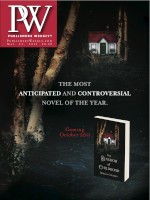In one of the first profiles on Jo Nesbø that appeared recently in the U.S., in April in the Wall Street Journal, the comparison was made right off the bat in the headline. The comparison was to Stieg Larsson, the Swedish crime novelist whose Millennium trilogy became a multimillion-copy bestseller in the States after exploding in Europe. Nesbø may not have much more in common with Larsson than a loose bit of geography and the fact that they write in the same genre—he is certainly not the first bestselling Scandinavian crime writer the publishing industry has tried to slap a "next Stieg Larsson" tag on—but he seems to be getting traction where others have not.
If there is a little more sense that Larsson is in the air, it may be in part because Knopf, which started drumming up publicity for The Girl with the Dragon Tattoo at this time in 2008, right before BEA, with a major "this is the big book of the fall," campaign, is doing the same now. For Girl, Knopf touted a 100,000-copy announced first printing and, among other things, blanketed the press with ARCs that featured a letter from publisher Sonny Mehta singing the praises of Larsson's heroine, Lisbeth Salander. For Nesbø's The Snowman, which came out May 10 and is the first of three books featuring the detective Harry Hole that Knopf will release, the announced first printing is 150,000, and the letter this time is from Paul Bogaards, executive director of publicity, saying the book "scared the shit out of me."
While Nesbø is coming at a moment when the market seems saturated with bestselling Scandinavian writers—among many others there's been Liza Marklund (Red Wolf, Atria, Feb.), Camilla Läckberg (The Ice Princess, Pegasus, summer 2010), and Kjell Eriksson (The Hand That Trembles, Minotaur, Aug.)—he's coming from the same imprint and editor that delivered Larsson, and, already, he seems to be catching fire in a way none of the others have. Bogaards said Knopf went back for a second printing before publication and, in the first five days on sale, The Snowman (in all formats) moved 17,000 copies, while The Girl with the Dragon Tattoo (in all formats) moved 16,000 in that same period. Bogaards also noted that between 60% and 65% of sales on The Snowman are coming from e-books.
Like some of the aforementioned Scandinavian writers who American publishers are now trying to break, Nesbø is not entirely new to U.S. readers. HarperCollins published three of his Harry Hole books—The Redbreast (2007), Nemesis (2009), and The Devil's Star (2010)—but Knopf is banking on The Snowman tipping the scales here for him the way it did in the U.K.; Nesbø sold modestly there, until The Snowman, which has sold well beyond the one million mark. (In his native Norway, with a 10th the population, Nesbø's books have sold over two million copies.) Bogaards said that HC laid the foundation for Nesbø in the U.S., and after seeing the way British readers have taken to The Snowman, his American moment has arrived. Opting to release The Snowman first—shuffling the order in which the three Harry Hole books Knopf acquired were originally published in Norway—is also part of the strategy. Bogaards thinks this novel is arguably Nesbø's best, and the goal is to "hook people on the really good junk, to use a drug analogy." The timing, he said, is to package the book as a great summer read and an ideal Father's Day gift.
Nesbø, Bogaards added, may also be benefiting from the current rush for all things Scandinavian. There's the AMC hit TV show The Killing, which is a direct import of a hugely popular Danish series. Then there are the movies. The Swedish-produced film franchise based on Larsson's books have brought in, Bogaards said, more than $175 million worldwide, and, in Hollywood, all eyes are on the Sony franchise that is set to launch in December with David Fincher's adaptation of The Girl with the Dragon Tattoo. Nesbø is also now hooked into the American film machine. At the Berlin Film Festival, Magnolia Pictures secured distribution to the feature adaptation of Nesbø's Headhunters, which is coming out in Norway this summer. (Magnolia is planning to release the film in American theaters in the fall, and Vintage will publish a paperback edition of the book when the film debuts locally.) Nesbø has also closed his first deal to do an English-language film based on his work: he sold the dramatic rights to The Snowman to Working Title. Depending on how Fincher's Girl is received, Bogaards thinks that a feature of The Snowman could easily serve as an anchor for a Nesbø film franchise.
Of course, for Nesbø, and Knopf, the key is getting The Snowman to continue on its strong word-of-mouth, in or out of the shadow of Stieg Larsson. While the media outlets will undoubtedly keep circling the story about the next Stieg Larsson, the reviewers, so far, have had no shortage of comparisons in praising this novel (which, by the way, is about an Oslo detective hunting a serial killer who takes out cheating wives only when there is fresh snow on the ground). In the full-page ad Knopf took out in the May 15 New York Times Book Review, the featured critics cited Stephen King, The Wire, and Silence of the Lambs—along with Larsson.



 Volume 258
Issue 21
05/23/2011
Volume 258
Issue 21
05/23/2011





